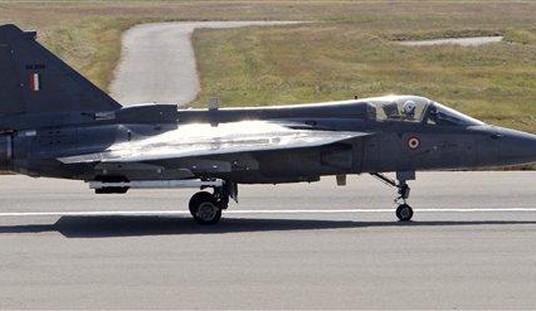A working example of the alliance between Left wing causes and Islamism is the relationship between Hugo Chavez and Hezbollah. When the US Treasury Department added two Venezuelans of Middle Eastern origin to the list of specially designated global terrorists, Venezuelan strongman Hugo Chavez immediately denounced it as the opening attempt to bring him before an international court. “Chavez says the United States is using accusations that the Venezuelan government is supporting the Lebanese group Hezbollah to ‘see if the world will make a move’ against him.”
The Department of the Treasury named two men, one of whom was actually a Venezuelan diplomat, as being front-men for the Iranian-backed international terrorist organization. The other ran a travel agency, the better to book individuals on visa-less direct flights now shuttling between Caracas and Teheran, with returns via Damascus, Syria. According to a Treasury press release:
Ghazi Nasr al Din is a Venezuela-based Hizballah supporter who has utilized his position as a Venezuelan diplomat and the president of a Caracas-based Shi’a Islamic Center to provide financial support to Hizballah. Nasr al Din served until recently as Charge d’ Affaires at the Venezuelan Embassy in Damascus, Syria, and was subsequently appointed the Director of Political Aspects at the Venezuelan Embassy in Lebanon. … Ghazi Nasr al Din has met with senior Hizballah officials in Lebanon to discuss operational issues, as well as facilitated the travel of Hizballah members to and from Venezuela.
US officials have reason to suspect that the subject of these “operational issues” meetings was hostile operations by Hezbollah against the US and its allies. It’s no secret that Iran has been trying to establish itself in the Western Hemisphere to attack America. Admiral James Stavridis, head of the US Southern Command expressed the fear in early 2008 that “the connectivity between narcoterrorism and Islamic radical terrorism could be disastrous in this region … Mahmud Ahmadinejad, president of Iran, a state that sponsors terrorism … is a very dangerous man and he is in this area of the world … he wants to have an embassy in every country in this region.”
“Narcoterrorism” — with which Hezbollah seeks to ally — in its current form is exemplified by the largest left wing insurgency in the world, the Fuerzas Armadas Revolucionarias de Colombia or FARC. The insurgency had traditional Leftist roots and like most of them drifted to drugs. “The FARC was established in the 1960s as the military wing of the Colombian Communist Party. The FARC originated as a guerrilla movement. The group later became involved with the cocaine trade during the 1980s for the purposes of fundraising, which caused an official separation from the Communist Party and the formation of a political structure it calls the Clandestine Colombian Communist Party.” But to keep up appearances, Marx and Lenin have recently been supplemented by Hugo Chavez’s Bolivarian ideology, whose policy of state control over economic activity is explained by appealing to the teachings of Jesus Christ. In a speech Chavez gave while visiting the US he argued that Jesus was the epitome of involvement in class struggle, social justice, and human rights organizations: in short, someone like Hugo himself.
Chavez of course, omitted from his theological discourse all mention of the magic word money, which apparently motivates more armed men than the Sermon on the Mount. After having bought the loyalty of the Venezuelan military by allowing them a free hand in corruption and racketeering, Chavez hoped to cement his domestic and regional political power through oil largesse. Provided the price of oil remains high and enough largesse is distributed, Chavez might well maintain his influence not just upon upon the poor of Venezuela, but also upon the desperados of FARC. In March, 2008, a cross-border raid by the Colombian military against a FARC encampment in Ecuador which resulted in the death of it’s second highest commander provided the first direct proof of social justice in action. The raid netted the FARC commander’s laptop. It contained information suggesting that FARC was not only receiving money from Chavez, but actively planning to traffic in uranium materials to make “dirty bombs” for profit. Chavez’s conception of the teachings of Jesus was very elastic indeed.
communications with other members of the FARC seven-person general secretariat, Venezuelan president Hugo Chávez, senior Ecuadorian officials, and an outline of the FARC’s political and economic strategy. … it is clear that that FARC received a large sum of money from Chávez in 2007, although it is unclear if the money is a loan or a gift … FARC’s apparent willingness to engage in trafficking of material (uranium) that could be used for a low-grade nuclear bomb. The type and grade of uranium in question indicate the FARC had been the victim of a scam or was planning on perpetrating a scam on an unsuspecting third party.
Certainly the United States has been paying attention to the growing linkages between FARC, Chavez and Hezbollah. Recently, two of the world’s biggest arms dealers, Victor Bout and Monzer al-Kassar were caught in sting operations by the Drug Enforcement Administration for trying to sell weapons to FARC, including surface to air missiles. Both are scheduled to stand trial in New York City. But though some observers, like Gustavo Coronel, see the Treasury ban against the Hezbollah agents working in Chavez’s diplomatic service as the prelude to a serious effort against Hugo, the American efforts may be limited to containment. For one thing, the problem of the narco/Islamic terror alliance is bigger than Chavez alone.
Southcom Commander Admiral James Stavridis’ testimony before the House Armed Services Committee in May (see video part 2/3) described the deep roots of the narcoterrorist challenge in South America; he categorically rated Islamic terror very secondary to the “narcoterrorist” axis itself. While Chavez was the most virulent exponent of Latin American Leftism/Bolivarianism, he was supported by a broad cast of anti-American regional allies. In an earlier press conference, Stavridis used photographs to indicate the enemy coalition.
Stavridis accompanied his comments with a photograph of Iranian President Mahmud Ahmadinejad standing alongside Bolivian President Evo Morales. … Stavridis showed another photograph with Morales standing next to presidents Hugo Chavez of Venezuela and Rafael Correa of Ecuador…. “Today in Latin America there is a competitive environment for us politically,” Stavridis said, alluding to leftist Venezuela’s growing influence across the region. We need to show why our ideas are better, are sensible (and) will produce good results,” he said, referring to “capitalism, free trade agreements, human rights, democracy and liberty.”
Chavez, Morales and Correa — and in the wings, Cuba — the hemispheric challenge was a large one. Hezbollah has long been aware of South American politics, and has sought to exploit the widespread culture of corruption, racketeering and anti-Americanism to build up its own network. For the moment, the conventional wisdom is that Islamic terrorism will be content to grow in the shadow of Bolivarianism, avoiding direct conflict with the US until it is ready. This assessment is embedded in a recent ABC News report that “intelligence agencies … are warning of mounting signs that Hezbollah, backed by Iran, is poised to mount a terror attack against ‘Jewish targets’ somewhere outside the Middle East” — presumably in Latin America. ABC quoted former CIA intelligence officer Bob Baer as saying “his Hezbollah contacts told him an attack against the US was unlikely because Iran and Hezbollah did not want to give the Bush administration an excuse to attack.” But that emphasized, rather than minimized the long term danger that Hezbollah posed to the Western Hemisphere. Homeland Security chief Michael Chertoff warned Fox News that Hezbollah was patiently watching and waiting for the right time to strike:
Someone described Hezbollah like the A-team of terrorists in terms of capabilities, in terms of range of weapons they have, in terms of internal discipline. To be honest, they make Al Qaeda look like a minor league team.
Hezbollah was growing, always growing, wherever it could. Even far to the south of Venezuela it was putting down roots among the gangs in the Tri-Border Area (TBA) of Argentina, Paraguay and Brazil. A US Army Journal noted:
Ambassador Philip Wilcox, former Department of State (DOS) Coordinator for Counterterrorism, testified before the International Relations Committee of the U.S. House of Representatives that Hezbollah activities in the TBA have involved narcotics, smuggling, and terrorism. Many believe the TBS’s Arab and Muslim community contains hardcore terrorist sympathizers with direct ties to Hezbollah, the pro-Iranian, Lebanese Shiite terrorist group; Hamas, the Palestinian fundamentalist group; the Egyptian group Islamic Jihad; and even al-Qaeda.
And Hezbollah was establishing roots within Venezuela itself that would outlive the Chavez regime; from business outposts on Venezeuela’s Margarita Island free trade zone to Muslim converts among the Wayuu tribe. While Washington seemingly incapable of strategic patience, Iran through Hezbollah was playing a long and deadly game against America.
Contribute to the Belmont Club.










Join the conversation as a VIP Member